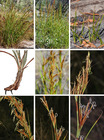Cyperaceae taxon details
Ammothryon grandiflorum (Nees ex Lehm.) R.L.Barrett, K.L.Wilson & J.J.Bruhl
1678597 (urn:lsid:marinespecies.org:taxname:1678597)
accepted
Species
Elynanthus grandiflorus Nees ex Lehm. · unaccepted
Schoenus grandiflorus (Nees ex Lehm.) F.Muell. · unaccepted
terrestrial
(of Elynanthus grandiflorus Nees ex Lehm.) Lehmann, J. G. C. (1844). Novarum et minus cognitarum stirpium pugillus VIII, addita enumeratione plantarum omnium in his pugillis descriptarum. , available online at https://www.biodiversitylibrary.org/page/31259402
page(s): 54-55 [details]
page(s): 54-55 [details]
Lectotype (of Elynanthus grandiflorus Nees ex Lehm.) LD...
, Note A collection at CGE, labelled as Preiss 134...
Lectotype (of Elynanthus grandiflorus Nees ex Lehm.) LD 1732115, geounit Western Australia [details]
Lectotype LD 1732115, geounit Western Australia [details]
From editor or global species database
Type material A collection at CGE, labelled as Preiss 134 and the locality given as ‘in arenosis Boots Creek ad fluvium Canning’ is very similar to the lectotype material and is probably a duplicate of it. The label probably reflects Preiss’ field collection number, distributed to Lindley (now in CGE) before Lehmann allocated Plantae Preissianae numbers to the collection (see McGillivray 1975; Nordenstam 1980; Crisp 1983; Wilson 1983; Lander 1987; Marchant 1990). [details]
Description Perennial tufted herbs, 0.7–1.5 m high; rhizome thick, 10–22 mm diam., sometimes pseudobulbous; roots sand-binding;...
Distribution Endemic to the South West Botanical Province in Western Australia, in near coastal areas from Kalbarri south and east to...
Description Perennial tufted herbs, 0.7–1.5 m high; rhizome thick, 10–22 mm diam., sometimes pseudobulbous; roots sand-binding; plants clonal, 0.3–1 m across; caudex present; old leaf sheaths covering the caudex, not breaking apart into fibres with age, pale brown to reddish brown. Culms stout, erect, leafy, with 4–7 nodes, obtusely trigonous, 2.5–7 mm diam., somewhat ribbed, usually scabrous but otherwise glabrous, base enlarged. Leaves basal and cauline, numerous, reducing in size up the culm, ultimately bract-like; phyllotaxy loosely spirotristichous, sheath scabrous, especially on upper leaves, loose around culm, 20–28(–38) mm long, not broader than the leaf lamina, upper margin with short, thick, brownish hairs, ligule absent; lower leaf lamina (150–)220–460 mm long, 5–15 mm wide, lamina ± linear, flat or usually folded, margins and prominent midrib scabrous, apex gradually attenuate. Inflorescence open, panicle-like, narrow, 120–750 mm long, 20–45 mm wide; with 7–14 nodes, bracts leaf-like, exceeding the spikelet clusters; branches spreading, with (1–)3–12 spikelets on peduncles 7–16 mm long, arising in each bract axil; spikelet prophyll absent. Spikelets brown, very narrowly ovate, 12–22 mm long, with 10–14 glumes, finely and very shortly hairy, only topmost 2–4 fertile, all bisexual, basal glumes 3–6 mm long; fertile glumes 11–20 m long, glabrescent, acute, becoming acuminate; rachilla compact and not or scarcely sinuous in fruiting spikelets. Perianth absent. Stamens 3; anther connective 6–11 mm long, linear to subulate; anthers pale yellow, 7–10 mm long, with a glabrous apical appendage 1.0–1.5 mm long. Style 16–22 mm long, trifid; base 8–12 mm long, slightly enlarged so continuous with the nutlet, branches 8–10 mm long, hairy. Nutlet sessile, subovoid but base contracted, 3.2–3.8 mm long, 1.8–2.2 mm diam., with three white ribs that broaden towards the apex; embryo not examined. Photosynthetic pathway inferred from anatomy to be C3. 1C = 0.39 pg. [details]
Distribution Endemic to the South West Botanical Province in Western Australia, in near coastal areas from Kalbarri south and east to...
Distribution Endemic to the South West Botanical Province in Western Australia, in near coastal areas from Kalbarri south and east to Israelite Bay. [details]
Cyperaceae Working Group. (2025). [see How to cite]. Global Cyperaceae Database. Ammothryon grandiflorum (Nees ex Lehm.) R.L.Barrett, K.L.Wilson & J.J.Bruhl. Accessed at: https://www.cyperaceae.org/aphia.php?p=taxdetails&id=1678597 on 2025-09-12
Date
action
by
2024-12-10 11:47:54Z
unchecked
db_admin
![]() The webpage text is licensed under a Creative Commons
Attribution 4.0 License
The webpage text is licensed under a Creative Commons
Attribution 4.0 License
Nomenclature
original description
(of Elynanthus grandiflorus Nees ex Lehm.) Lehmann, J. G. C. (1844). Novarum et minus cognitarum stirpium pugillus VIII, addita enumeratione plantarum omnium in his pugillis descriptarum. , available online at https://www.biodiversitylibrary.org/page/31259402
page(s): 54-55 [details]
basis of record Plants of the World Online (POWO). , available online at https://powo.science.kew.org/ [details]
new combination reference Mueller, F. (1875). Fragmenta phytographiae Australiae. Vol. 9. Melbourne. Auctoritate Gubern. Coloniæ Victoriae, Ex Officina Joannis Ferres. 216 p., available online at https://www.biodiversitylibrary.org/item/7226
page(s): 30; note: Combination: Schoenus grandiflorus (Nees ex Lehm.) F. Muell. [details]
new combination reference Barrett, R. L.; Bruhl, J. J.; Wilson, K. L. (2021). Revision of generic concepts in Schoeneae subtribe Tricostulariinae (Cyperaceae) with a new genus <i>Ammothryon</i> and new species of <i>Tricostularia</i>. <em>Telopea.</em> 24: 61-169., available online at https://doi.org/10.7751/TELOPEA14844
page(s): 76 [details] Available for editors [request]
[request]
page(s): 54-55 [details]
basis of record Plants of the World Online (POWO). , available online at https://powo.science.kew.org/ [details]
new combination reference Mueller, F. (1875). Fragmenta phytographiae Australiae. Vol. 9. Melbourne. Auctoritate Gubern. Coloniæ Victoriae, Ex Officina Joannis Ferres. 216 p., available online at https://www.biodiversitylibrary.org/item/7226
page(s): 30; note: Combination: Schoenus grandiflorus (Nees ex Lehm.) F. Muell. [details]
new combination reference Barrett, R. L.; Bruhl, J. J.; Wilson, K. L. (2021). Revision of generic concepts in Schoeneae subtribe Tricostulariinae (Cyperaceae) with a new genus <i>Ammothryon</i> and new species of <i>Tricostularia</i>. <em>Telopea.</em> 24: 61-169., available online at https://doi.org/10.7751/TELOPEA14844
page(s): 76 [details] Available for editors
 Present
Present  Inaccurate
Inaccurate  Introduced: alien
Introduced: alien  Containing type locality
Containing type locality
Isolectotype B, geounit Western Australia [details]
Isolectotype BM 000900956, geounit Western Australia [details]
Isolectotype G 00195328, geounit Western Australia [details]
Isolectotype G 00195329, geounit Western Australia [details]
Isolectotype HBG
1522312, geounit Western Australia [details] Isolectotype L 0042719, geounit Western Australia [details] Isolectotype L 0042720, geounit Western Australia [details] Isolectotype MEL 2295791, geounit Western Australia [details] Isolectotype MEL 2295792, geounit Western Australia [details] Isolectotype NY 00021817, geounit Western Australia [details] Isolectotype P 00585272, geounit Western Australia [details] Lectotype (of Elynanthus grandiflorus Nees ex Lehm.) LD 1732115, geounit Western Australia [details] Lectotype LD 1732115, geounit Western Australia [details]
1522312, geounit Western Australia [details] Isolectotype L 0042719, geounit Western Australia [details] Isolectotype L 0042720, geounit Western Australia [details] Isolectotype MEL 2295791, geounit Western Australia [details] Isolectotype MEL 2295792, geounit Western Australia [details] Isolectotype NY 00021817, geounit Western Australia [details] Isolectotype P 00585272, geounit Western Australia [details] Lectotype (of Elynanthus grandiflorus Nees ex Lehm.) LD 1732115, geounit Western Australia [details] Lectotype LD 1732115, geounit Western Australia [details]
From editor or global species database
Description Perennial tufted herbs, 0.7–1.5 m high; rhizome thick, 10–22 mm diam., sometimes pseudobulbous; roots sand-binding; plants clonal, 0.3–1 m across; caudex present; old leaf sheaths covering the caudex, not breaking apart into fibres with age, pale brown to reddish brown. Culms stout, erect, leafy, with 4–7 nodes, obtusely trigonous, 2.5–7 mm diam., somewhat ribbed, usually scabrous but otherwise glabrous, base enlarged. Leaves basal and cauline, numerous, reducing in size up the culm, ultimately bract-like; phyllotaxy loosely spirotristichous, sheath scabrous, especially on upper leaves, loose around culm, 20–28(–38) mm long, not broader than the leaf lamina, upper margin with short, thick, brownish hairs, ligule absent; lower leaf lamina (150–)220–460 mm long, 5–15 mm wide, lamina ± linear, flat or usually folded, margins and prominent midrib scabrous, apex gradually attenuate. Inflorescence open, panicle-like, narrow, 120–750 mm long, 20–45 mm wide; with 7–14 nodes, bracts leaf-like, exceeding the spikelet clusters; branches spreading, with (1–)3–12 spikelets on peduncles 7–16 mm long, arising in each bract axil; spikelet prophyll absent. Spikelets brown, very narrowly ovate, 12–22 mm long, with 10–14 glumes, finely and very shortly hairy, only topmost 2–4 fertile, all bisexual, basal glumes 3–6 mm long; fertile glumes 11–20 m long, glabrescent, acute, becoming acuminate; rachilla compact and not or scarcely sinuous in fruiting spikelets. Perianth absent. Stamens 3; anther connective 6–11 mm long, linear to subulate; anthers pale yellow, 7–10 mm long, with a glabrous apical appendage 1.0–1.5 mm long. Style 16–22 mm long, trifid; base 8–12 mm long, slightly enlarged so continuous with the nutlet, branches 8–10 mm long, hairy. Nutlet sessile, subovoid but base contracted, 3.2–3.8 mm long, 1.8–2.2 mm diam., with three white ribs that broaden towards the apex; embryo not examined. Photosynthetic pathway inferred from anatomy to be C3. 1C = 0.39 pg. [details]Distribution Endemic to the South West Botanical Province in Western Australia, in near coastal areas from Kalbarri south and east to Israelite Bay. [details]
Habitat Occurs close to the coast on sandplains, consolidated sand dunes and limestone in Banksia and jarrah-marri woodland, occasionally extending inland along rivers. [details]
Identification Perhaps most similar in general appearance to the much smaller Morelotia octandra, which is very distinctive in usually having eight anthers (vs three), and spikelets 10–15 mm long with 7(–9) glumes (vs 12–22 mm long with 10–14 glumes). [details]
Reproduction Flowers recorded for (March–)April–July. Fruit recorded from July–October. [details]
Type material A collection at CGE, labelled as Preiss 134 and the locality given as ‘in arenosis Boots Creek ad fluvium Canning’ is very similar to the lectotype material and is probably a duplicate of it. The label probably reflects Preiss’ field collection number, distributed to Lindley (now in CGE) before Lehmann allocated Plantae Preissianae numbers to the collection (see McGillivray 1975; Nordenstam 1980; Crisp 1983; Wilson 1983; Lander 1987; Marchant 1990). [details]
| Language | Name | |
|---|---|---|
| English | Large Flowered Bog-rush | [details] |
JSTOR Plants (Elynanthus grandiflorus Neex ex Lehm. LD1732115 type 1) Note: Lectotype
To Biodiversity Heritage Library (13 publications) (from synonym Schoenus grandiflorus (Nees ex Lehm.) F.Muell.)
To Biodiversity Heritage Library (2 publications)
To Biodiversity Heritage Library (7 publications) (from synonym Elynanthus grandiflorus Nees ex Lehm.)
To European Nucleotide Archive, ENA (Ammothryon grandiflorum)
To European Nucleotide Archive, ENA (Schoenus grandiflorus) (from synonym Schoenus grandiflorus (Nees ex Lehm.) F.Muell.)
To GenBank (2 nucleotides; 0 proteins)
To GenBank (2 nucleotides; 0 proteins) (from synonym Elynanthus grandiflorus Nees ex Lehm.)
To GenBank (4 nucleotides; 0 proteins) (from synonym Schoenus grandiflorus (Nees ex Lehm.) F.Muell.)
To Genève Herbarium (Elynanthus grandiflorus G00195328 isotype 1) (from synonym Elynanthus grandiflorus Nees ex Lehm.)
To Genève Herbarium (Elynanthus grandiflorus G00195329 isotype 1) (from synonym Elynanthus grandiflorus Nees ex Lehm.)
To International Plant Names Index (IPNI) (from synonym Elynanthus grandiflorus Nees ex Lehm.)
To International Plant Names Index (IPNI)
To International Plant Names Index (IPNI) (from synonym Schoenus grandiflorus (Nees ex Lehm.) F.Muell.)
To Plants of the World Online (from synonym Schoenus grandiflorus (Nees ex Lehm.) F.Muell.)
To Plants of the World Online
To Plants of the World Online (from synonym Elynanthus grandiflorus Nees ex Lehm.)
To the Natural History Museum, London (Schoenus grandiflorus F.Muell. BM000900956 type 1) (from synonym Schoenus grandiflorus (Nees ex Lehm.) F.Muell.)
To Biodiversity Heritage Library (13 publications) (from synonym Schoenus grandiflorus (Nees ex Lehm.) F.Muell.)
To Biodiversity Heritage Library (2 publications)
To Biodiversity Heritage Library (7 publications) (from synonym Elynanthus grandiflorus Nees ex Lehm.)
To European Nucleotide Archive, ENA (Ammothryon grandiflorum)
To European Nucleotide Archive, ENA (Schoenus grandiflorus) (from synonym Schoenus grandiflorus (Nees ex Lehm.) F.Muell.)
To GenBank (2 nucleotides; 0 proteins)
To GenBank (2 nucleotides; 0 proteins) (from synonym Elynanthus grandiflorus Nees ex Lehm.)
To GenBank (4 nucleotides; 0 proteins) (from synonym Schoenus grandiflorus (Nees ex Lehm.) F.Muell.)
To Genève Herbarium (Elynanthus grandiflorus G00195328 isotype 1) (from synonym Elynanthus grandiflorus Nees ex Lehm.)
To Genève Herbarium (Elynanthus grandiflorus G00195329 isotype 1) (from synonym Elynanthus grandiflorus Nees ex Lehm.)
To International Plant Names Index (IPNI) (from synonym Elynanthus grandiflorus Nees ex Lehm.)
To International Plant Names Index (IPNI)
To International Plant Names Index (IPNI) (from synonym Schoenus grandiflorus (Nees ex Lehm.) F.Muell.)
To Plants of the World Online (from synonym Schoenus grandiflorus (Nees ex Lehm.) F.Muell.)
To Plants of the World Online
To Plants of the World Online (from synonym Elynanthus grandiflorus Nees ex Lehm.)
To the Natural History Museum, London (Schoenus grandiflorus F.Muell. BM000900956 type 1) (from synonym Schoenus grandiflorus (Nees ex Lehm.) F.Muell.)







